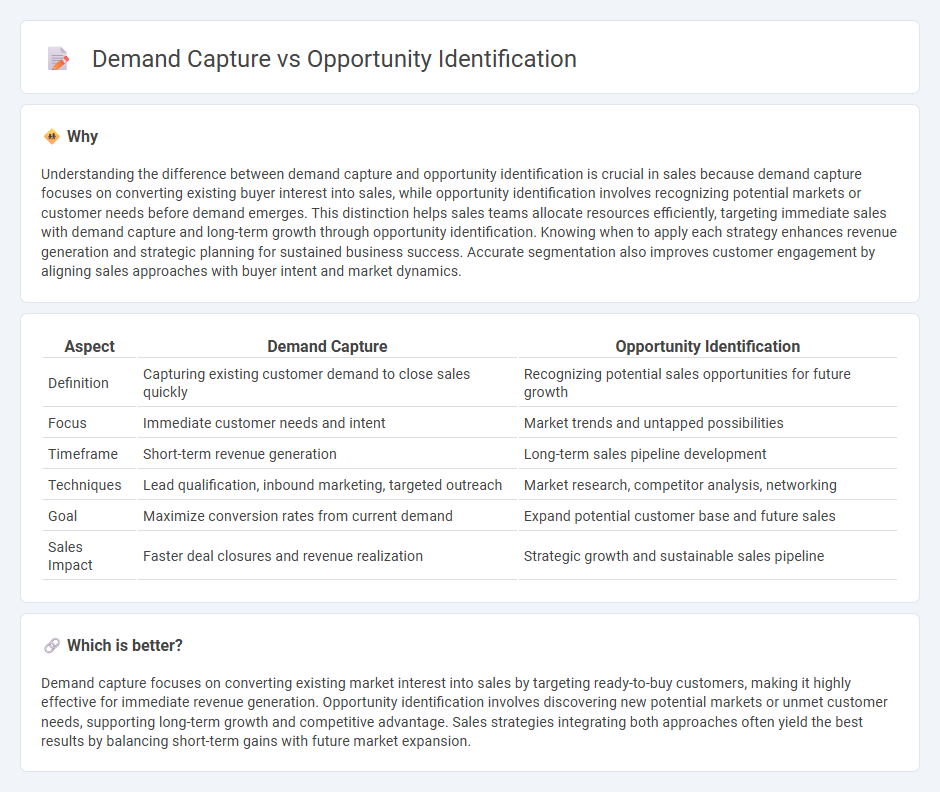
Demand capture focuses on converting existing customer interest and inquiries into sales by responding to explicit market needs. Opportunity identification involves proactively discovering potential sales prospects through market analysis, customer behavior insights, and emerging trends. Explore more to understand how combining both strategies can maximize revenue growth.
Why it is important
Understanding the difference between demand capture and opportunity identification is crucial in sales because demand capture focuses on converting existing buyer interest into sales, while opportunity identification involves recognizing potential markets or customer needs before demand emerges. This distinction helps sales teams allocate resources efficiently, targeting immediate sales with demand capture and long-term growth through opportunity identification. Knowing when to apply each strategy enhances revenue generation and strategic planning for sustained business success. Accurate segmentation also improves customer engagement by aligning sales approaches with buyer intent and market dynamics.
Comparison Table
| Aspect | Demand Capture | Opportunity Identification |
|---|---|---|
| Definition | Capturing existing customer demand to close sales quickly | Recognizing potential sales opportunities for future growth |
| Focus | Immediate customer needs and intent | Market trends and untapped possibilities |
| Timeframe | Short-term revenue generation | Long-term sales pipeline development |
| Techniques | Lead qualification, inbound marketing, targeted outreach | Market research, competitor analysis, networking |
| Goal | Maximize conversion rates from current demand | Expand potential customer base and future sales |
| Sales Impact | Faster deal closures and revenue realization | Strategic growth and sustainable sales pipeline |
Which is better?
Demand capture focuses on converting existing market interest into sales by targeting ready-to-buy customers, making it highly effective for immediate revenue generation. Opportunity identification involves discovering new potential markets or unmet customer needs, supporting long-term growth and competitive advantage. Sales strategies integrating both approaches often yield the best results by balancing short-term gains with future market expansion.
Connection
Demand capture involves recognizing and engaging potential customer needs at early stages, which directly feeds into opportunity identification by highlighting viable sales prospects. Effective data analysis and market research enhance demand capture accuracy, enabling sales teams to pinpoint high-value opportunities. This interconnected process drives targeted sales strategies and maximizes revenue potential.
Key Terms
**Opportunity Identification:**
Opportunity identification involves recognizing unmet market needs and emerging trends that can lead to innovative product development and competitive advantage. This process entails analyzing customer pain points, market gaps, and technological advancements to uncover potential areas for growth and investment. Explore how mastering opportunity identification can drive your business strategy and open new revenue streams.
Lead Generation
Opportunity identification involves recognizing potential markets or customer segments where lead generation efforts can be most effective, leveraging data analytics and market research to pinpoint high-value prospects. Demand capture centers on converting these prospects by utilizing targeted campaigns, personalized messaging, and timely calls-to-action to maximize lead engagement and conversion rates. Explore advanced strategies for optimizing your lead generation funnel and improving ROI.
Market Segmentation
Opportunity identification involves analyzing market segmentation to uncover unmet needs and emerging trends within specific customer groups, enabling businesses to tailor innovative products or services. Demand capture focuses on leveraging detailed segment data to effectively target and convert potential customers through strategic marketing and sales efforts. Explore how advanced market segmentation techniques can enhance both opportunity identification and demand capture for sustained business growth.
Source and External Links
Opportunity Identification: How Good Are You? - Gilroy Associates - Opportunity identification is a key leadership skill involving the discovery and monetization of creative yet rational business opportunities, from small process tweaks to disruptive industry changes, demonstrated by successful entrepreneurs.
Opportunity Identification For Successful Business Innovation - Opportunity identification in business refers to analyzing market, competition, and customer needs to find unique value propositions for growth, emphasizing understanding Jobs to Be Done (JTBD) and thorough market opportunity analysis.
Chapter 3: Opportunity Identification - Opportunity identification is a structured process involving generating many ideas, screening and developing them through steps such as establishing an innovation charter and selecting exceptional opportunities to focus innovation efforts.
 dowidth.com
dowidth.com